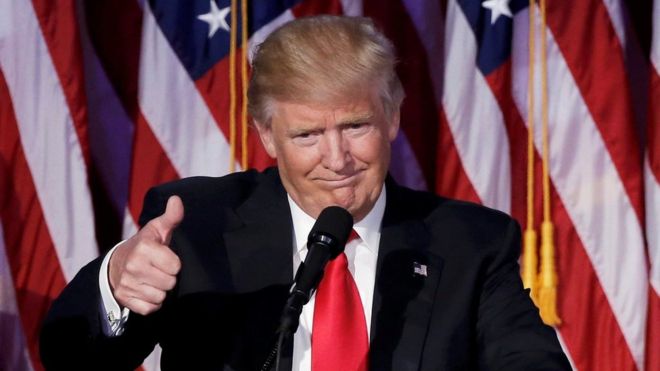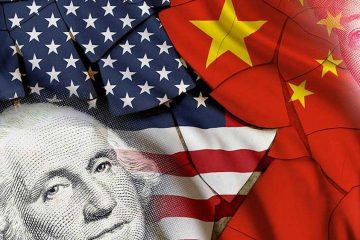The unexpected victory of businessman Donald Trump Tuesday night in the race to become America’s 45th president sent shockwaves through global markets.
Though S&P 500 and Nasdaq futures fell 5% overnight, U.S. markets managed to recoup those losses and even post gains in early Wednesday trading. Dow Jones futures plummeted by over 800 points Tuesday night, but the Dow Jones Industrial Average was up by about 1% by noon Eastern Time Wednesday. Japan’s Nikkei 225 was down 5% after a slide on Wednesday morning, but the Shanghai Composite, which fell as much as 1.3% in early trading, largely reversed those losses.
Perhaps more telling were movements in bond markets: Treasury yields were much higher as of midday, as investors anticipated that Trump’s plans for tax cuts and infrastructure spending would widen U.S. deficits and drive up interest rates.
As for what comes next, no one can be even remotely sure. The presidential seat will be the first political position Trump has ever held, and already the president-elect has promised many policies challenging the status quo. He has threatened to impose much higher tariffs on imports from Mexico and China, alongside other rhetoric that threatens globalization.
Here’s what analysts in the financial world have to say:
Citi‘s group of analysts, led by Tina Fordham, commented on the surprise Republican capture of the White House and its retention of majorities in the Senate and House. The team noted that Trump’s tenure in the White House will likely be marked by uncertainty, and could put the expected December Federal Reserve interest rate hike on hold. The Citi team wrote:
Trump has no experience in government, and his tenure as President will likely be marked with unconventional, and potentially erratic, policymaking that departs substantially from the political modus operandi of the past, whether Republican or Democrat. This expectation of change was a major driver of his popular appeal, but it is likely to unsettle markets….A Republican sweep of the White House and both chambers of Congress raises the risk that Trump will find support to pursue his more ambitious campaign agenda items such as invoking a trade war that may weaken US net exports and reduce business investment. This is our near-term recession risk scenario, that likely would either keep the Fed on hold indefinitely, or even prompt interest rate cuts to offset the recession-related damage to the US and global economies.”
Evercore ISI‘s Terry Haines noted that while the Senate, House, and White House are now united under the Republican party, the divide between Trump and his party still exists. That suggests that the uncertainty Trump might bring to the presidency will be tamped down by Congress—meaning less volatility for global markets.
Put bluntly, Trump cannot unilaterally change laws or regulations with the stroke of a pen. This Congress and its leaders — Speaker Ryan and Majority Leader McConnell — are intent on restoring the legislative branch as a coequal branch of government: one plank of Ryan’s “Better Way” legislative proposals is about ways to achieve that goal regardless of who becomes president. The new Republican Congress, in proportion very like the current one, is not going to kowtow to a President Trump, but rather will seek to drive the policy agenda. It is for this fundamental reason that we continue to favor the “pragmatic” Trump over the “populist” Trump scenario: Congress will not permit presidential freelancing both for constitutional and purely political reasons.”
Cowen‘s Chris Krueger though noted that the “smashing win” will result in a cabinet that reinforce’s Trump’s campaign behavior in a analysis bracketed by lyrics from Lynyrd Skynyrd’s “Tuesday’s Gone.” Now investors must wait to see who will be in Trump’s cabinet.
“Trump sworn-in as President on January 20 with a GOP House and Senate. Budget reconciliation rules mean passage of tax/ health care/deficit bills with simple majority. Trump unilateral power on tariffs,” Krueger wrote. Over the next 100 days, he added that investors should watch out for these scenarios: “Democratic Party meltdown/ circular firing squad; Tea Party/Trump coup against Paul Ryan (Sean Hannity stated last night he should not be Speaker); President Obama reaction, Lame Duck – literally zero chance for Judge Garland, TPP, or anything else of meaning; Trump Cabinet announcements (Trade posts will be key to watch); Trump dialogue with House and Senate GOP leaders (this is also critical – and is the anchor on the Bull Trump Case).”
PNC Asset Management‘s Chief Investment Strategist Bill Stone added that the market’s dip is no surprise. Historically, markets have fallen after election day before providing long term gains. Stone said in a statement:
“It is worth remembering that the day after the election, market activity is not very instructive for longer-term returns. Though stocks are sharply lower post-election, recall that the S&P 500 was more than 5% lower the day after Obama’s 2008 victory, but up 14.9% over the next 12 months.”
He added in a note that historically, this quarter (the fourth quarter or the fourth year in a presidential cycle), results in a relief rally that shows the highest quarterly performance compared to any other quarter. But investors should expect market lows in the next quarter, as markets try to assess a new political atmosphere, and how it’ll affect the economy.
Goldman Sachs’ U.S. Chief Equity Strategist David Kostin opined that Trump’s win would have little effect on the S&P 500.
“We expect the equity market response to the election result will be limited. The US economy has been expanding for seven years and continues to grow at a subdued pace. Goldman Sachs Economics forecasts 2017 real GDP growth will average 2%. Inflation has been slowly climbing towards the Fed’s 2% target. Investors anticipate the FOMC will hike interest rates next month. The ten-year US Treasury yield now equals 1.93%. We expect the US stock market will climb slowly during the next few years in line with earnings growth, ending 2017 at 2200 and 2018 at 2300.”
TD Ameritrade Executive Vice President Steven Quirk told Fortune that markets seemed to have overreacted to the surprise win, at least initially.
“If you look at the initial moves, its quite similar to what happened in Brexit and other major events,” Quirk noted. “The major difference in Brexit and this event is there will be continued volatility is what will happen to their investments.” Quirk also noted that with or without Trump, the economy should be heading into a slowdown. “We are in the eight year of a bull market. And people understand that it doesn’t last. But I wouldn’t expect monstrous gains in the next year or two. If it does go up it will be a grind.”
A team of Fitch Ratings analysts and directors noted that while Trump’s win would have no effect on the U.S.’s current AAA credit rating, his proposed policies would hurt the country’s rating in the medium-term. The team wrote:
Government debt/GDP would rise dramatically were the tax cuts to be implemented in full. The net loss of revenue stemming from the planned cuts to individual and corporate income tax rates has been estimated by the Urban-Brookings Tax Policy Center at $ 6.2 trillion (a third of 2016 GDP) over a 10-year horizon compared with the current baseline scenario published by the Congressional Budget Office, which already forecasts federal debt/GDP to rise by 9pp of GDP by 2025. A rapid move into substantial fiscal deficit by the US could push up borrowing costs.”
CFRA Research, formerly S&P Market Intelligence, noted that the Republican sweep is a negative for the U.S. solar industry. CFRA equity analyst Angelo Zino wrote in a Wednesday note:
The U.S. solar industry has prospered over the last 8 years, with our forecast of annual installations substantially increasing from a run rate of less than 500 megawatts in ’08 to more than 13 gigawatts in ’16. We believe a Trump presidency along with a Republican-led Congress poses significant risks to a potential reduction/elimination of the 30% ITC, extended at the end of ’15. While we have had a negative tilt on solar, and see peak U.S. demand in ’16, we think the election outcome adds uncertainty. We have Sell opinions on JinkoSolar and SolarEdge.
Mizuho’s U.S. Chief Economist Steven Ricchiuto also weighed in:
The deficit widening and international trade aspects of this shift in policy explains why bond yields have pushed higher in the wake of this extension of this populist revolt against the statuesque. Initially I will be looking for important technical points to bring in buyers, but 2% may not be the number where the market finds support, a declining currency reflexes global investor dismay at the result. A weaker currency helps reduce the risk of importing deflation providing an incentive for domestic investors to see how the dust settles before putting money to work. Globally, a stronger yen suggest more from the BOJ and it should ease concerns about an ECB taper.


